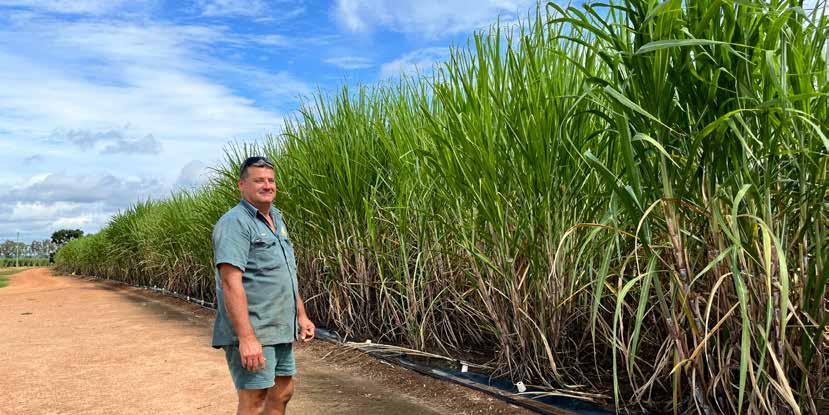
2 minute read
SRA32 ON ITS OWN PATH
Chris Vella standing in front of Q240 A (foreground) and SRA32 (background) in February 2022.
By Helen Cook
Advertisement
Dr Jason Eglinton
SRA32 started its evaluation as just one of 100,000 seedlings facing a 12year journey of trials and tests before becoming a released variety with the risk of being discarded at every step.
The experimental clone began life in the field as a single plant at the SRA Brandon site in 2009 and survived the selection process to be planted in its first series of final assessment trials (FATs) in 2015. Further results indicating commercial potential would be required for it to make the cut to be included in a second series of FATs before consideration of commercial release by the Burdekin Regional Variety Committee (RVC). An opportunity to support this would come six years later. The Board of Mitr Phol (MSF parent company) visited an SRA trial site at Mulgrave in late 2017 to discuss plant breeding and future varieties. Dr Jason Eglinton, Executive Manager Variety Development had only recently joined SRA and was thrown the challenge of developing a different type of sugarcane, better suited to electricity production, without compromising grower returns from sugar production. That meant developing a variety that had a greater fibre production but didn’t sacrifice the amount of sugar content per hectare; something quite different to the conventional balance of traits under selection.
“The standard selection program typically takes 12 years from planting a seedling to variety release,” Dr Eglinton said. “Commercial evaluation of a new prototype variety needed to be done much faster. Rather than start from the very beginning, the pipeline of germplasm already in the selection program was examined for possible candidates to meet this brief.”
The experimental clone QS09-8404 had only completed plant and first ratoon harvests in its first FAT series in the Burdekin at that time and was identified as a contender.
“In those initial trials QS09-8404 had shown a 24 tonnes per hectare yield advantage over the standard varieties, an increase of 0.9% fibre, and 0.6 units reduction in CCS. On a fibre and sugar per hectare basis it was selected as the most promising clone,” Dr Eglinton said.
Commercial scale clean seed is only produced for released varieties and some of the most advanced experimental clones. The next challenge was to fasttrack the establishment of production for commercial scale milling trials at the MSF Tableland Mill. In 2018 a small clean seed plot at Meringa was used as starting material for tissue culture production which was then planted in 2019 on an MSF-owned farm under a collaboration agreement with SRA.
As is often the way in experiments, life and business happens, and during the trial MSF sold the property with the pilot study but were keen to see the experiment progress. New owner Bray’s Farming were happy to be involved and the study continued.
“In 2021 we saw the first commercial scale deliveries go from the property to the Tableland Mill – eight bins, harvested










